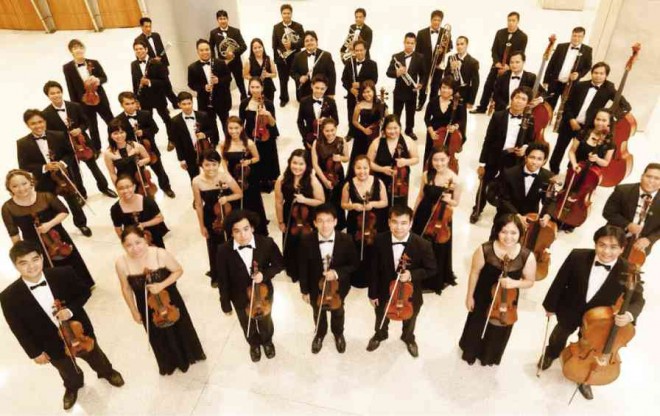
The Manila Symphony Orchestra (MSO) was founded in 1926 by the Viennese conductor Alexander Lipay, and reorganized in 2001 by its longtime concertmaster Basilio Manalo with Sr. Mary Placid, OSB, dean of St. Scholastica’s Colege School of Music, through the Philippine Research for Developing Instrumental Soloists (Predis).
At its relaunch as Manila Symphony II, Manalo gave the baton to professor Arturo Molina, who has since been the MSO’s conductor.
Molina is also a virtuoso of the violin. I heard him a few years ago at Santiago Hall in BDO and he really had the audience smiling because of his God-given musical tones and heartfelt expression.
It was then that I understood why he, as a student at Kiev and Moscow conservatories, won the String Department Competition, the first foreign student to excel in the annual event.
He has made the MSO one of the best orchestras in the Philippines.
First in Asia
The MSO is considered the first orchestra in Asia to present regular performance of classical works. At its original launch in 1926, maestro Lippay already conducted the works of Beethoven, Brahms and Wagner (bulwarks of Romanticism).
For its 88th anniversary concert held in BDO, the MSO performed the symphonies of Haydn, Mozart and Beethoven (VIPs of the Classical era). Haydn is considered the “father of the symphony.”
Inspired by the Italian overture which had three movements—an allegro, an andante and a dance-like movement (a minuet or a gigue)—Haydn added a fourth movement, presto in rondo or sonata—allegro form, because he thought the third movement’s dance-like rhythm of the Italian overture was not effective enough as a finale.
Instructive
Jeffrey Solares, the young and intelligent executive director of the MSO, gave the opening address and explained the program, which was very instructive for the audience.
A slow introduction opened Haydn’s “Symphony in G Major No. 88,” followed by the first theme, softly but gaily ushered in by the strings (without the basses) and repeated by the whole orchestra in full force with the basses joining with a figure all its own.
Two themes followed. After a flowery free fantasia in contrapuntal technique, the movement closed with a coda recapitulating the first theme.
Oboes and cellos introduced a slow and lonely melody in the second movement with the violas, basses, bassoons and horns in accompaniment.
When the theme returned, the violins joined the accompaniment with its own counter melody.
After a transitional orchestral section, lead violins and flute, and later the oboe and the cellos stated the theme followed by the development and short coda.
The audience relaxed in the familiar third movement, Minuet G Major in triple time, and further enjoyed the last movement, “Allegro Con Spiritu” Rondo in 2/4 time in G Major, based on a peasant dance.
This symphony reminded me of a well-bred and humble lady, who has graceful manners, her cries not loud, her pains not fully revealed, her diet in healthy moderation—in other words, an ideal, modestly attired, classic lady!
There were four soloists in Mozart’s “Sinfonia Concertante for Winds in Eb Major”—Jayson Paktakhan, oboe; Randolf Lopez, clarinet; Ariel Perez, bassoon; and Celso de Leon Jr., horn. All principal players, they entranced the audience with their peerless rendition of this work.
The MSO throbbed with fresh power. While the soloists had vibrant passages, the orchestra was not just an accompaniment but a strong participant in the working of the theme and development.
There were many smiles among the audience.
Standing ovation
The MSO then performed Beethoven’s “Symphony no. 1 in C major op. 21.” It essayed the first movement “allegro con brio” with a 12-measure “Adagio molto” introduction, which did not start in C major but a discordant F-major modulating to G major and which did not resolve to C major until the beginning of the “allegro con brio” movement proper.
We noticed drums beating dotted notes in the dominant to a tricky tune in F-major in the second movement, “Andante cantabile con moto.”
The third movement, although still titled “Minuet and Trio,” was full of verve and modulations, rising to a wild cresendo in the trio as the minuet was repeated.
This was really already the joking scherzon of Beethoven’s later works.
Approval
Violins opened the final movement with a slow-rising playful scale passage leading to the “allegro molto e vivace” theme interpreted by the strings ending in whirlwinds of happiness and humor.
Although the first presentation of this Beethoven “Symphony No. 1 in C major, op. 21,” conducted by Paul Wranitzky and premiered in Vienna in 1800, was described as “shameful” in a Leipzig newspaper, this scintillating work has steadily gained approval in the MSO’s exciting performance during its 88th anniversary. The enchanted audience spontaneously rose to a resounding, never-ending ovation.
At the raffle conducted for MSO subscribers, MSO board of trustees president Maan Hontiveros went up the stage to hand over an iPad Mini to winner Rod Cornejo.